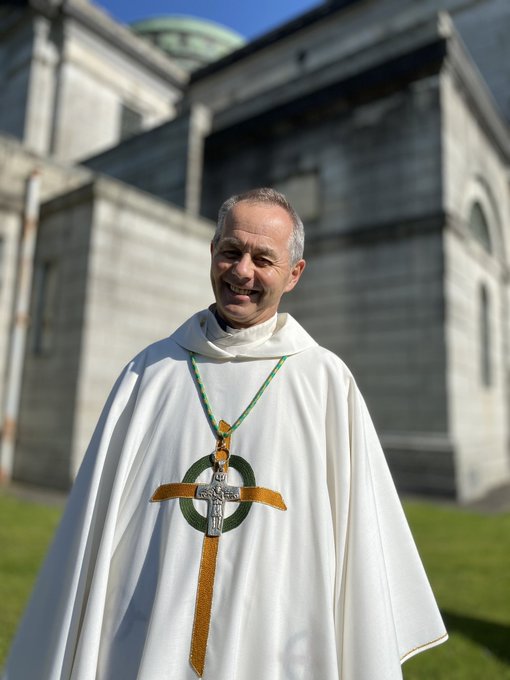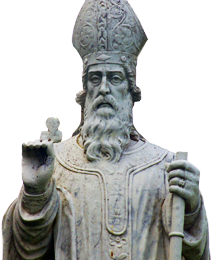
Early life, education and career
Bishop Martin Hayes was born in Borris (Newhill), Two-Mile-Borris, Thurles, Co Tipperary on 24 October 1959. His late parents were Daniel and Mary Agnes (née Bowe), and Martin is the eldest of five sons and three daughters, one of whom died in infancy.
Martin received his primary school education in Saint Kevin’s National School, Littleton and secondary school education in CBS, Thurles. In September 1977, he began his studies in Production Engineering at NIHE Limerick, now the University of Limerick. As part of the course programme he worked at Wyeth Ireland in Askeaton, Co Limerick (1979) and at Ecco Ltd in Dundalk, Co Louth (1980). Martin graduated in 1981 with a BSc in Manufacturing Technology. In November 1981 Martin took up a position as a quality engineer with Amdahl Computers in Swords, Dublin, completing his initial orientation with the parent plant in Silicon Valley, California, where he was given responsibility for setting up quality control systems for new products.
During his studies in Limerick, Martin became involved in Muintearas Íosa, a youth faith initiative which continues to keep the three flames of Fáilte (welcome), Foghlaim (learning) and Guí (prayer) alive in the diocese. He was instrumental in organising Muintearas Íosa events in Dublin and in his native Archdiocese of Cashel & Emly in the early 1980’s.
Entry to seminary, ordination, further studies, teaching at Saint Patrick’s College, Thurles, and work with ACCORD Marriage Care
In September 1983, Father Martin entered Saint Patrick’s College, Thurles, to study for the priesthood in the Archdiocese of Cashel & Emly. Having completed a Certificate in Philosophical Studies and a Diploma in Theology he was ordained deacon on 4 April 1988, and to priesthood on 10 June 1989, by Archbishop Dermot Clifford who was Archbishop of Cashel & Emly at the time.
Father Martin undertook further studies to the Gregorian University, Rome, and completed a Licentiate in Philosophy (Anthropology) in 1991 while staying at the Pontifical Irish College. He was then appointed to the teaching staff at Saint Patrick’s College, Thurles, and taught philosophy until 2001. During this period of his ministry, Father Martin worked as a marriage preparation course facilitator with Accord, served as its Diocesan Director with the personnel of the Thurles and Tipperary centres, and established an administrative office to coordinate Accord’s activities. In 1997, he was appointed Bursar at Saint Patrick’s College, Thurles. As part of diocesan millennium initiatives and in cooperation with the then Mid-Western Health Board, Father Martin was instrumental is setting up SUAS (Suicide: Understanding and Support) – a listening service for those bereaved by suicide. Throughout his time at Saint Patrick’s College he worked in parishes in the Diocese of Sacramento, California, during the summer months.
In August 2001, Father Martin undertook a sabbatical year studying at the Jesuit School of Theology, Berkeley, California, and separately at Tabgha Farm – Centre for Ecology & Spirituality, located in Cessnock, New South Wales, Australia.
Appointment to parish work and involvement with diocesan initiatives
In September 2002, Father Martin was appointed as curate to Thurles Parish with responsibility for Saints Joseph & Brigid Church, Bothar na Naomh. He resumed his facilitation of marriage preparation courses with Accord Thurles, served on the Accord National Executive Council and provided supervisory support for Accord personnel in the South-East Region. He became an active member of the ‘Cashel & Emly Ongoing Formation and Education of Priests Committee’ from its inception in 2003.
Father Martin worked as a part-time lecturer in Introduction to Philosophy on the newly established Bachelor of Arts in Education, Business Studies & Religious Studies course for secondary school student teachers which was delivered in Saints Patrick’s College, Thurles. He also engaged with the two-year Ecology & Theology programme provided by the Columban Fathers, in Dalgan Park, Navan, Co Meath, on an audit basis.
In July 2007, Father Martin was appointed Administrator of the Cathedral of the Assumption, Thurles. Working in collaboration with a group of lay people, he encouraged the celebration of relationships with the established voluntary organisations in Thurles, promoting the ongoing development of pastoral outreach and faith development groups which culminated in the formation of a Parish Pastoral Council in 2017.
During Father Martin’s term as Administrator, Saints Joseph & Brigid’s Church, Bothar na Naomh was renovated, a Pastoral Centre (Lámh Chunta) was constructed and the cathedral presbytery was refurbished. Father Martin was elected a member of the Cashel & Emly Council of Priests, having previously served as its recording secretary and was appointed as a member of the diocesan committee for safeguarding children.
Father Martin co-ordinated preparations for the Episcopal installation of Archbishop Kieran O’Reilly SMA at the Cathedral of the Assumption, Thurles, on 8 February 2015. Elected chairman of the new Council of Priests, and re-elected in 2020, Father Martin became involved as a member of the newly established Diocesan Pastoral Council. He was also a member of the Seinn Diocesan Committee which promotes and organises liturgical singing and music events involving the secondary school students at the cathedral.
Appointment to pastoral planning and development work
In August 2017 Father Martin was appointed to the full-time position of Director of Pastoral Planning & Development in the Archdiocese of Cashel & Emly and he took up residence at the Parochial House, Knockanrawley, Tipperary Town. In conjunction with the Diocesan Pastoral Council, he co-ordinated the diocesan-wide ‘Listening Process’ with 46 parishes over 2017-18, alongside a ‘Listening to Priests’, commissioned by the Archdiocese.
In preparation for the 9th World Meeting of Families (WMoF) and the visit of Pope Francis to Ireland in 2018, Father Martin served as delegate for the diocese and this involved chairing its WMoF Diocesan Committee, organising a Diocesan Family Fun Day, producing a Family Prayer Booklet and co-ordinating diocesan liturgies.
After WMoF Father Martin’s focus returned to the diocesan consultation as the outcomes of both listening processes became the subject of ongoing discussion with priests and parish groups at ‘Gatherings of Parishes’ throughout 2019. This has resulted in the establishment of necessary supports for priests and interim training for parish leadership groups. A draft pastoral plan was formulated in spring 2020 and feedback is currently being processed with a view to implementing a Diocesan Pastoral Plan for parishes over the years 2020-2025.
Pope Francis appointed him as Bishop of Kilmore on the Solemnity of SS. Peter and Paul, Monday 29 June 2020.
He was ordained bishop in the Cathedral of SS. Patrick & Felim in Cavan on Sunday 20 September 2020 at 3:00p.m. by Archbishop Eamonn Martin of Armagh and and Primate of All-Ireland, assisted by the Papal Nuncio to Ireland, Archbishop Jude Thaddeus Okolo, and Archbishop Kieran O’Reilly SMA of Cashel and Emly as co-consecrators.
COAT OF ARMS & MOTTO

Following a custom dating from the mid-twelfth century, most bishops adopt a crest or coat-of-arms. The bishop chooses elements that hold personal meaning for him in relation to his ministry, and these are combined in a display on a shield. Heraldic tradition places a stylised hat called a galero above the shield, shown in green, with six tassels on either side, and behind the shield a processional cross.
Bishop Martin’s crest has two sections and two background colours. On the left is a representation of the Kilmore crest with Jerusalem Cross, Pastoral Staff and Mitre. On the right is Bishop Martin’s personal expression of how we as a pilgrim people (Camino Shell) are anchored in our faith in being invited to be part of the relationship of the Trinity (Shamrock) through the Eucharist (Grain and the Grapes).
As his motto, displayed below the shield, Bishop Martin has chosen ‘Your steadfast love endures’ (Ps 136:6) to indicate that God’s love is paramount. God’s love is evident from the moment of creation, estimated by cosmologists to be some 13.8 billion years ago, leading to the formation of stars, the galaxies, our solar system to include the Earth, the beginning of plant life, animal life and human life. Each one of us is ‘made in the image and likeness of God’ (Genesis 1:27) and each one of us is called to respond to God’s love in our loving of each other and our caring for all of life.
The Symbols of Bishop Hayes’ Ministry
THE RING
The ring represents his nuptial bond with the Church while the crozier or pastoral staff illustrates his pastoral ministry as ‘shepherd of the flock’.
Bishop Martin’s ring recognises the marriage of his parents, Daniel and Mary Agnes, as it is made from the ring worn by his mother.

THE MITRE
The mitre is placed on his head and signifies the Church’s commission to pursue holiness. Bishop Martin’s mitre was made by Sr Gabrielle in the Poor Clare Monastery, Ennis, Co. Clare. The design is based on Bishop Martin’s priestly ordination vestments which were made by Sr Nellie Ryan, R.S.M., Cashel in 1989.

THE CROZIER
The crozier illustrates the ministry of bishop as a ‘shepherd of the flock’
Bishop Martin’s crozier or pastoral staff is made of different woods, each of which has particular significance for him. He commissioned Joey Burns of Irish Wood Sculpture in Cavan to construct the pastoral staff consisting of four different timbers:- bog oak from the native parish of his mother, Mary Agnes (nee Bowe), Rathdowney-Errill in the Diocese of Ossory; ash from his own birthplace in Borris, Two-Mile-Borris, Thurles, Co. Tipperary; sycamore from a tree planted by Bishop William Bedell in 1632 which still stands at Kilmore beside where the pre-Reformation Catholic cathedral of St Feidhlimidh was located and adjacent to the present-day Church of Ireland St Feidhlimidh’s Cathedral. The pastoral staff is engraved with Celtic Christian symbols and features inserts of yew from the lands of St Oliver Plunkett in Loughcrew, Oldcastle, Co. Meath.

THE BISHOP’S CHAIR (Cathedra)
The cathedra is the seat of a bishop in the principal church of a diocese, usually a cathedral.
It is a symbol of the bishop’s teaching authority.
Pope Benedict XVI explained the symbolism in a homily given on the feast of the Chair of St. Peter in 2006:
The “Cathedra” literally means the established seat of the Bishop, placed in the mother church of a diocese which for this reason is known as a “cathedral”; it is the symbol of the Bishop’s authority and in particular, of his “magisterium,” that is, the evangelical teaching which, as a successor of the Apostles, he is called to safeguard and to transmit to the Christian Community.
When a Bishop takes possession of the particular Church that has been entrusted to him, wearing his miter and holding the pastoral staff, he sits on the cathedra. From this seat, as teacher and pastor, he will guide the journey of the faithful in faith, hope and charity.
The chair reminds the bishop of his duties to his flock, and its size (since it is usually larger than other sanctuary furnishings) denotes the immense weight that is placed on his shoulders as chief shepherd of the local area. It’s a special honour, one that comes with great responsibility.






